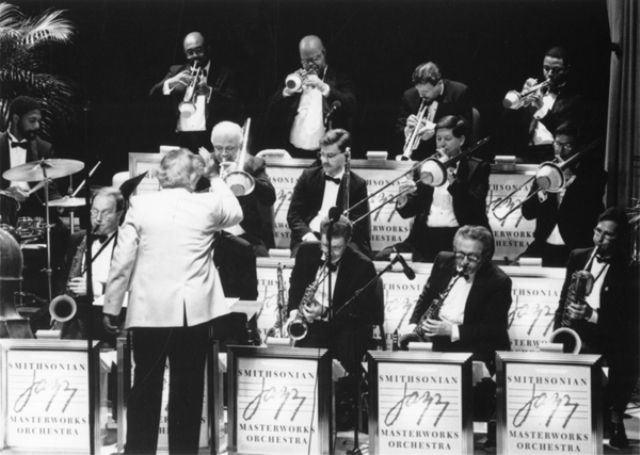From photos to manuscripts, letters to videos, at the Smithsonian Institution Archives (SIA) there is a broad range of materials that need archivists’ attention. For me, working as an intern this summer at SIA, the focus has been jazz. That’s right, my internship has involved listening to and, most importantly, preserving the recordings of the Smithsonian Jazz Masterworks Orchestra and the radio show Jazz Smithsonian.
The Smithsonian Jazz Masterworks Orchestra was created by a Congressional appropriation in 1990 in recognition of the importance of jazz to American culture. Though the National Museum of American History has a superb collection of jazz music and recordings, Masterwork’s Orchestra co-director Gunther Schuller (at a concert on June 24, 1995) argued that “these pieces need to be played by living, breathing musicians lest that music die or atrophy, because . . . a musical tradition cannot be kept alive only in archives or on recordings.”
The concerts themselves were started as acts of live, cultural preservation and now fifteen years later, we are archiving recordings of the concerts with the very same motivation. Not only do these recordings feature world-class musicians (who co-director David Baker bragged had learned how to play each style with historical accuracy) and interviews with musicians and family members of the musicians, but in some cases the recordings capture pieces that had not been heard as originally intended in decades as well. For example, Jeru by Gerry Mulligan:
Introduction to Jeru by Gerry Mulligan.
Jeru, by Gerry Mulligan
My summer tasks at SIA are a little more difficult than just listening to these amazing concerts. The recordings, usually about an hour in length, have to be brought over onto the computer in real-time, with no room for breaks or pauses which makes software freezes and power surges my ongoing nightmares. I just recently completed one box of 46 tapes, totaling just over 48 hours of recordings! Also, I’ve had to do quite a bit of research on the format used: digital audio tapes or DATs. Remember those? Popular in the late 1980s and 90s in production studios and archives due to their digital nature (though they look like regular cassettes), DATs and their players are no longer manufactured and players still in superb working condition are few and far between (ours is on loan from Smithsonian Folkways). Plus, few institutions are doing their own DAT conversions, making my investigation into best practices a bit more difficult. Deciding on which audio editing software to use, the best format to convert to, and what exactly the archive can support, both in terms of cost and storage space, has required tireless research, seeking help from those more knowledgeable than myself—namely audio engineers and musicians—and several compromises. At times, the process of preserving these tapes, and working in digital preservation in general, can be both exciting and, sometimes maddening!  Given this frustration, listening to swinging pieces such as Dizzy Gillespie’s Manteca on a daily basis sure does help. Manteca, by Dizzy Gillespie.
Given this frustration, listening to swinging pieces such as Dizzy Gillespie’s Manteca on a daily basis sure does help. Manteca, by Dizzy Gillespie.
Produced by the Smithsonian Institution Archives. For copyright questions, please see the Terms of Use.


Leave a Comment